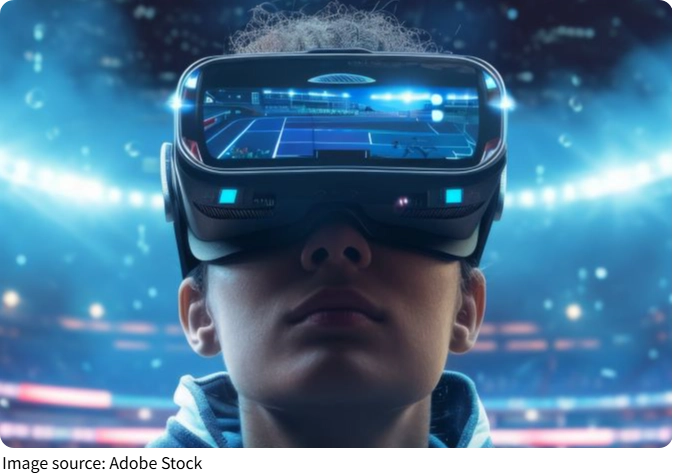Immersive VR Gaming

We all love the thrill of playing video games, whether it's exploring vast worlds, solving complex puzzles, or fighting epic battles. But what if we could take that experience a step further?
What if we could actually feel like we're inside the game, interacting with everything around us in real time?
This is where virtual reality (VR) comes into play. VR technology is revolutionizing how we experience games, offering players an unprecedented level of immersion and interaction. So, how exactly does VR work in gaming, and what makes it so special?
In this article, we'll explore how VR technology is reshaping the gaming experience, allowing players to step into entirely new worlds and become part of the action. From realistic graphics to intuitive controls, we'll take a look at the key elements that make VR games feel so real.
What is Virtual Reality (VR)?
To understand how VR enhances gaming, we need to first understand what virtual reality is. At its core, VR is a technology that allows users to interact with a computer-generated environment in a way that simulates real-world interactions. This is typically achieved through VR headsets, which display stereoscopic images, and sensors that track the player's head movements, hand gestures, or even full-body movements.
When we put on a VR headset, we are immediately transported into a new world. This environment could be anything—from a futuristic city to the depths of the ocean, or even an alien planet. The immersive experience comes from the headset's ability to track our movements, allowing us to look around, walk, and interact with the game world as if we were physically present. VR isn't just about seeing the game—it's about experiencing it.
The Immersion Factor: Feeling Like You're Really There
One of the biggest draws of VR gaming is the sense of immersion it offers. Unlike traditional gaming setups, where you play on a flat screen, VR allows you to step into the game. This creates a much deeper connection to the game world. For instance, in VR, you can turn your head to look around, and the game's environment responds as if you're truly there. Want to check out that distant mountain or turn around to see what's behind you? In VR, you can do just that.
This level of immersion helps you forget you're playing a game, making everything feel incredibly lifelike. You can touch objects, move through space, and feel as though you're participating in the story or mission rather than just controlling a character.
The sense of presence is often so convincing that many players report feeling physical sensations like dizziness or motion sickness—a sign of how real the experience feels.
How VR Enhances Interaction in Games
Another key benefit of VR is its ability to make gameplay more interactive. Traditional games use buttons or joysticks to control characters and actions. But with VR, your body movements become the controller. You can reach out and physically grab items, swing weapons, or even jump over obstacles. This level of interaction allows for more natural, intuitive gameplay.
For example, in a VR game where you're exploring a jungle, you might physically duck to avoid a low-hanging branch or use your hands to catch a flying object.
Moreover, VR games can also include multiplayer elements that let players interact in a shared virtual space. This creates an opportunity for social experiences that are much more engaging than voice chats or text-based communication. You can see your friends' avatars, collaborate in real-time, or even face off against each other in virtual arenas. This transforms the gaming experience into something more social and participatory.
The Realism of VR Games: Graphics and Sound
Of course, a big part of what makes VR games so immersive is the stunning graphics and sound. VR developers go to great lengths to make the virtual environments as realistic as possible. For example, high-definition graphics and 3D audio are used to create environments that feel lifelike.
The visual realism in VR games helps trick your brain into thinking you're actually there. Coupled with spatial audio—where sounds change depending on your location or movement in the game—this makes the experience even more immersive.
In games like Beat Saber, the combination of fast-paced music, glowing blocks, and your own movements helps create an energetic, realistic feeling of being inside a rhythm-based world. The visual and auditory stimulation in VR is designed to create a fully engaging sensory experience.
The Future of VR in Gaming
While VR is already making a huge impact in the gaming world, its potential is far from fully realized. As the technology improves, we can expect even more immersive experiences. Future VR games might incorporate haptic feedback, where you can feel vibrations and even sensations like the wind on your face.
With the development of more advanced motion tracking and brain-computer interfaces, we could one day be able to control games with just our thoughts, making the line between reality and the virtual world even blurrier.
In addition, VR gaming could expand beyond entertainment to other areas like education, therapy, and training. Imagine using VR to learn a new language, practice surgery, or train for a job—all within a fully interactive, realistic environment. As the technology becomes more accessible and affordable, VR could transform how we experience not just games, but the world around us.

Conclusion: The Magic of Virtual Reality
In the end, VR is changing how we experience games by bringing us closer to the action than ever before. It's not just about playing—it's about truly stepping into new worlds and feeling the rush of excitement, fear, or joy as though we're actually there. From immersive gameplay to interactive environments and realistic sound and visuals, VR technology is pushing the boundaries of what gaming can be.
So, the next time you strap on a VR headset, remember: you're not just playing a game; you're living it. Are you excited to experience virtual reality for yourself? Let us know your thoughts and share your VR experiences in the comments!
-
 Pixels to Powerhouse ArtFrom clunky pixels to breathtaking worlds—has gaming become today’s boldest art form? The transformation is jaw-dropping!
Pixels to Powerhouse ArtFrom clunky pixels to breathtaking worlds—has gaming become today’s boldest art form? The transformation is jaw-dropping! -
 Immersive VR GamingHow Virtual Reality Transforms Gaming Experiences and Immerses Players into New Worlds!
Immersive VR GamingHow Virtual Reality Transforms Gaming Experiences and Immerses Players into New Worlds! -
 Smart NPCs in GamingHow AI Enhances NPCs to Avoid Robotic Behavior and Become More Dynamic
Smart NPCs in GamingHow AI Enhances NPCs to Avoid Robotic Behavior and Become More Dynamic